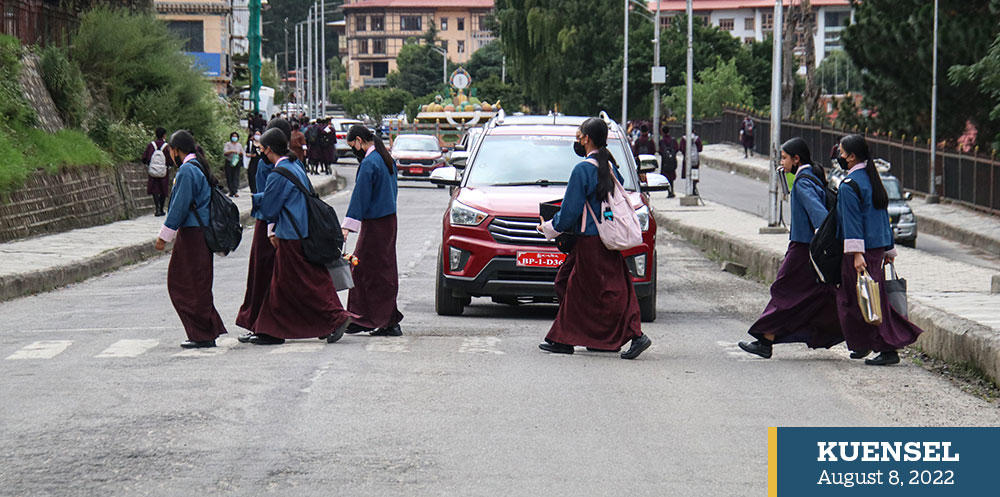There are no safe footpath, say students
Chhimi Dema
7:50 am, Thursday, Thimphu.
In 20 minutes, the assembly bell will ring and students will have to be in the assembly line. Pema and Sonam (name changed) are getting late. They cannot cross the road to get to the bridge at Lungtenzampa.
The two girls and five others donning the same school uniform have perched on the road divider on the busy Thimphu-Babesa expressway. They will rush when there is enough space between two rushing vehicles. One misstep and they could be run over by the drivers who are also rushing. The students literally fight for space to get to the other side.
Near the Bhutan Oil Distributor at Lungtenzampa, another group of students – both to get to the bridge and to the school inside the Royal Bhutan Police headquarters are keeping an eye on the police who will signal them to cross. The motorists are inconsiderate, perhaps they have children getting late for school in their vehicles. When it is time for the students to cross, the traffic becomes a mess.
“The road needs an expansion and the fuel station should be relocated,” says a student who told Kuensel that it is risky getting to school every morning. “Soon it will be summer vacation and we will forget it,” she says. “Madam, if you can, tell the government to change the road alignment.”
Commuting to school in the capital city is a challenge. Every morning, students as young as seven risk their life to get to school on time. While many drive by in vehicles, including government vehicles, many have to fight the increasing number of vehicles and decreasing walkways or safe footpaths to go to school.
Below the fly-over at Changbandu, a group of students – some with parents – keep their eyes on the broad two-lane expressway. The Bazam provides the shortest route to the school at Changjiji. Getting to it is risky. “Some drivers are considerate and give way, some even eyeball us when we try to cross,” said a student waiting to cross the road.
Bhutan’s capital city is not pedestrian-friendly. Students say it is the most difficult part of school life.
At Changzamtog, along the hospital road, there is a building being constructed at one end of the zebra crossing. The construction has eaten up a lot of space. Student traffic personnel are confused during rush hours. There is no space for students to wait to cross the road.
“It is an accident waiting to happen,” says Ugyen, a father of two children who takes the road every morning. “What are our town planners and policymakers doing? They should come out at 8 am and drive around the city,” he said, sounding frustrated at the scene.
The capital city’s road infrastructure has not changed much or is not able to keep up with the change. There are at least a few hundred vehicles added to the road every month, but the road network has not expanded to accommodate the traffic. This hampers pedestrians.
Apart from school children rushing for space, others are also finding the city congested and risky.
Lham, 25, who regularly jogs in the morning, said that the footpaths are mostly narrow and unstable. “The footpath ends in the middle or has holes in them. At night, it is risky to walk on the footpaths,” she added.
There are always risks of getting hit by vehicles while walking on narrow footpaths in the city. The footpath near the Changzamtog Middle Secondary School, for example, is highly risky for pedestrians.
There are no figures indicating how many students were injured while on their way to school or home. According to a 2020 police report, every month, on average, eight people are killed and 37 are injured in traffic accidents across the country.
Not many report minor accidents to police, says a parent when asked if students are at risk going to school or home. “Police are alerted or cases lodged only when serious accidents happen. But the situation now is a big accident waiting to happen.”
Many say that with the capital city’s roads in bad condition (pothole-ridden) motorists trying to avoid holes could hit pedestrians. “How will we encourage walking when walking is unsafe,” says a parent, Tshering Pelden.


